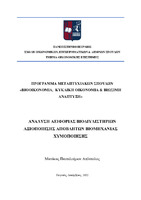Ανάλυση αειφορίας βιοδιυλιστηρίων αξιοποίησης βιομηχανιών χυμοποίησης

View/
Keywords
Αξιοποίηση αποβλήτων ; Ανάλυση αειφορίας ; Βιομηχανία χυμοποίησης ; Βιοδιυλιστήρια ; Βιοοικονομία ; Κυκλική οικονομία ; Ανάλυση κύκλου ζωήςAbstract
Circular economy and sustainable development are terms which are increasingly attracting
attention among policies and practices driven by nations and communities worldwide. While
society is trying to fight environmental pollution and scarcity of natural resources to meet the
Sustainable Development Goals by 2030, significant quantities of waste are produced from
the food manufacturing industries causing severe environmental problems and loss of
potential raw materials. Solely, in the EU, around 30.6 Mt of food waste is generated every
year at the processing and manufacturing stage of the food supply chain. Fruit processing
industries, primarily consisting of the juice industries, share a large portion of this amount.
This waste that mainly contains peels, internal tissue, seeds, and pomace is usually rich in
organic compounds such as carbohydrates, proteins and lipids. Their traditional
treatment/utilization technologies, limited to animal feeding, landfilling and incineration, are
not viable and sustainable solutions both from an environmental and economic point of view
as they fail to obtain value from each fraction of this waste.
Biorefinery development via integrated waste valorization technologies through
fractionation and/or (bio-)conversion of organic waste streams, can result in a spectrum of
products such as high value-added bioactive materials, biofuels, biochemicals and bioplastics.
This study is a meta-analysis of the available technologies developed at different scales that
give value to waste streams derived from the orange and juice industries. Initially, a detailed
methodology is applied via material flow analysis to systematically determine the available
waste quantities in the EU countries. A comprehensive sustainability analysis of the available
valorization technologies is then implemented by assessing the most critical circularity,
environmental and socio-economic indicators. The analysis is conducted both for emerging
and incumbent valorization technologies and specific conclusions are deduced highlighting
xii
all favorable valorization routes. Specifically, the incumbent technologies seem to gain
advantage in terms of energy consumption and time, and in product yield in some cases,
combined with better environmental performance than the conventional ones. In addition, the
complexity of the valorization scenarios seems to be proportionate to the environmental
performance and energy consumption and inverse proportionate with production cost.
Lastly, useful assumptions made, analyzing trade-offs between indicators, including
positive correlation between environmental indicators, among others.


